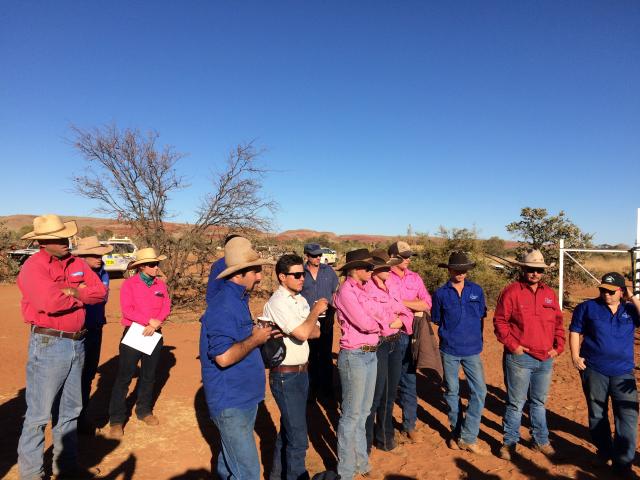Backgrounding beef for benefit

The Department of Agriculture and Food’s Northern Beef Futures (NBF) project is collaborating with industry groups to evaluate returns of backgrounding cattle.
Backgrounding is the practice of moving cattle from a breeding property to a secondary property to grow-out cattle to a specific weight to suit a target market.
By backgrounding cattle, pastoralists can gain access to higher-value markets and turn-off cattle at times of the year when cattle prices may be higher, but stations may be inaccessible by road due to weather conditions.
The Mingenew Irwin Group’s North South Beef Alliance (NSBA) project, supported by the department’s Agriculture Sciences Research & Development fund, aims to increase the number of cattle headed south for fattening and solidify the supply chain from northern pastoralists to southern backgrounders.
NBF Market Analyst Roger Verbrugge said that backgrounding cattle has the potential to open up more market options, including live exports, and entry to feedlots or South West-based meat processors.
Boxed beef markets have a range of different specifications which could provide pastoralists an alternative market option which can be accessed through backgrounding.
NSBA spokesperson Brooke Forsyth said that under the alliance, various arrangements were available for pastoralists including retained ownership of cattle and payment of backgrounding fees based on weight gain, including a fee per kilogram or profit share arrangement on kilograms added.
The NSBA project is developing a repeatable, quality controlled production system which reduces management risk for the backgrounder and provides a production management and oversight function for the pastoralist.
The Alliance expects the first intake of cattle from the pastoral regions to take place in May 2017. For further information, contact Brooke Forsyth on 0487 281 007.
The department’s NBF project has developed a backgrounding model to illustrate the economics of backgrounding northern cattle in the southern areas of WA.
Mr Verbrugge said a prototype of the model is available which will enable producers to input data specific to their property to see the return from a north-south alliance system under different conditions and using different cattle specifications.
The prototype, which he presented at the North South Beef Alliance field day held in September, received significant interest from producers.
For more information contact Roger Verbrugge, DAFWA NBF Market Analyst on +61 (0)8 9780 6166 or email nbf@agric.wa.gov.au
Stimulating infrastructure development
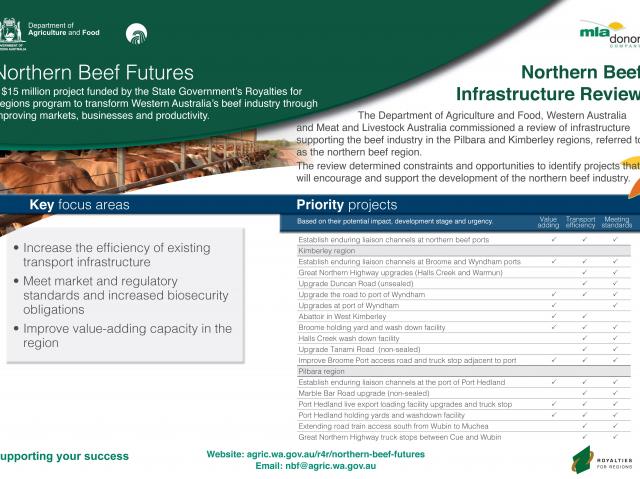
Eligible regional stakeholders can apply for a share of $600 000 in seed funding to deliver the priority projects identified in the Department of Agriculture and Food’s Northern Beef Infrastructure Review (NBIR).
DAFWA’s Northern Beef Futures (NBF) Infrastructure Development Manager Trina Anderson said that the NBIR was completed in March 2016 and identified priority infrastructure projects and how they might be developed to increase the value of the northern beef industry in the Kimberley and Pilbara regions of Western Australia.
The information underpinning the review has already been instrumental in supporting WA road funding submissions to the Australian Government, with NBF collaborating with industry and Main Roads department.
The NBIR provides a detailed understanding of current and future beef infrastructure needs in the Kimberley and Pilbara regions and identified 16 priority projects across the categories of value adding, transport efficiency and market and regulatory standards.
Trina said that the seed funding is intended to be distributed across all priority projects and applications are invited from eligible regional stakeholders including shires, development commissions, ports and other associations on an ‘as submitted’ basis until funding is expired, or until 30 April 2017.
More information on the type of projects expected to be funded is detailed in the Northern Beef Infrastructure Review (NBIR) and please refer to the Guidelines for Seed Funding for more information.
The department is also currently assessing applications received for grants of up to $500k to construct up to two (2) domestic cattle holding yards, to adjoin existing export-accredited depots in the Kimberley region that are to be publicly accessible to industry on completion.
For more information contact DAFWA NBF infrastructure development manager Trina Anderson on +61 (0)8 9368 3640 or email trina.anderson@agric.wa.gov.au
Mosaic agriculture working to expand beef production in WA’s northern rangelands
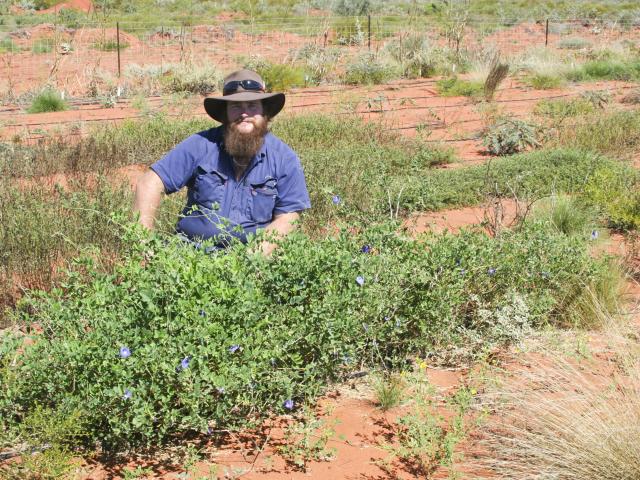
The Department of Agriculture and Food’s Northern Beef Futures (NBF) project’s mosaic agriculture development team of research officers Clinton Revell and Geoff Moore, together with technical support from Tyler Loud have been busy over recent months sampling irrigated fodder trials in the Pilbara and Kimberley regions.
Presentations on mosaic agriculture research activities have also been delivered at a range of conferences and visiting pasture scientists have been hosted to view trials in the region.
Two presentations were delivered at the Northern Beef Research Updates Conference (NBRUC) held in Rockhampton, Queensland in August: a general presentation outlining the work to quantify the production potential and feed quality for a range of forage options; and the approach to assessing the potential weed risk of improved pastures for the WA rangelands.
Department mosaic agriculture research is aimed at quantifying the production potential and feed quality for a range of forage options, encompassing dryland or irrigated improved pastures and fodder crops to broaden the feed-base of rangeland grazing systems.
For example, agronomy trials have been established under centre pivot irrigation at Kilto Station near Broome, at Warrawagine/Woodie Woodie in the Pilbara and at Gogo Station in the Fitzroy Valley which represent key soil-climatic zones in northern WA.
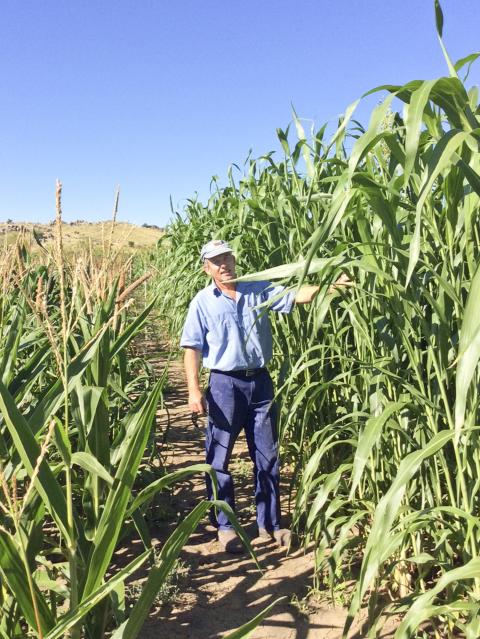
The second area of work involves weed risk assessment trials in the northern rangelands that aim to determine the invasiveness, impacts and potential distribution of a number of non-indigenous fodder varieties.
The approach involves a series of field nurseries established in key soil and climate environments in the West Kimberley and Pilbara to obtain data on the persistence and spread of a range of commercial pasture and fodder grasses and legumes which are widely used in similar environments in the Northern Territory and Queensland.
Sites, each with a range of grasses and legumes, have been established at Wallal Downs south of Broome, Birdwood Downs near Derby, Warrawagine/Woodie Woodie in the Pilbara and at Gogo Station in the Fitzroy Valley.
Irrigation was used to replicate an extremely high-rainfall scenario to help the plants get established, and the irrigation was gradually turned off over the wet season.
In terms of weed risk, the importance of data collection begins once the irrigation is turned off. Observations to date include:
Lablab and cowpea were the strongest-performing legumes at both Derby and Wallal sites over the dry season ‘winter’, but had senesced by early summer. There were no seedling recruits at either site even though they had produced large amounts of seed.
The best-performed legumes over the summer ‘wet’ season at Derby were the Caribbean stylo (S. hamata) and wynn cassia (Cassia rotundifolia).
Leucaena plants continue to be damaged by termites at the Wallal field nursery. Large termites (Mastotermes spp.) have hollowed out the taproot of some leucaena seedlings at Wallal Downs, resulting in the death of plants, and there has also been conventional mud tunnel damage and termites observed on leucaena stems. The mud tunnels were deliberately broken on some plants so they will persist.
Butterfly pea grew well following out-of-season rainfall at Wallal in early May, but grew slowly over summer, even with trickle irrigation.
Extreme temperatures experienced at Warrawagine in early January, a period of almost a week with maximum temperatures of about 45° Celcius, resulted in the death of almost all of the lablab and cowpea plants, which were 20 to 30cm in height, across all 12 replications in the field nursery. A number of maize plants were also killed (bleached) by the extreme temperatures.
Most of the warm season (C4) annual grasses and the C4 perennial grasses had good plant vigour and competed well with ‘weeds’, however after they senesced the annual grasses (sorghums and millets) at Derby were invaded by broadleaf weeds.
The Northern Beef Futures Mosaic Agriculture project is made possible by Royalties for Regions investment and the Meat and Livestock Australia Donor Company.
For more information about mosaic agriculture in the Pilbara and Kimberley regions, contact Clinton Revell, senior research officer on +61 (0)8 9368 3596, Geoff Moore, research officer on +61(0)8 9368 3293 or Tyler Loud, technical officer on +61 (0)8 9794 1477 or email nbf@agric.wa.gov.au.
BIG northern beef business improvements

Northern beef businesses in WA have received support from the Department of Agriculture and Food (DAFWA) to undertake business improvements to better meet export and domestic specifications and demand for WA beef and live cattle.
Nearly half of eligible beef production businesses in the Kimberley and Pilbara regions have taken up the department’s Northern Beef Futures (NBF) Business Improvement Grants (BIG) – an incentive of up to $25 000 to connect beef enterprises with business advice and mentoring to improve their competitiveness.
Department senior policy officer Christine Thompson said the BIG program was a vital component of the NBF project’s aim to facilitate practice change and build capability in the State’s northern beef industry.
It gives pastoralists the opportunity to review their business, identify key issues and make changes that will allow them to grow their business and their confidence to take advantage of new market opportunities.
Of the 54 participating businesses, 40 have completed the initial review and business plans, and are now preparing business-specific project proposals to implement changes.
DeGrey Station, located east of Port Hedland in the Pilbara, has a history of trialling innovative cattle management and livestock handling techniques and was one of the early adopters to receive the go-ahead to implement its business plan.
DeGrey owner-manager Mark Bettini said the opportunity to work with a consultant, review the station’s business and prepare a business plan as Part 1 of the BIG program had provided tangible results.
“It was a good process to go through; getting a business professional to look at our operation from the outside, with a ‘fresh set of eyes’.
“The review helped us identify the opportunity to easily improve herd data recording and analysis for more efficient and effective herd management decision-making to increase beef production and improve sustainability.
“As a result, we developed a project, broke it down into bite-sized steps on a timeline, and we now know how to get the job done and the people who will be responsible.”
The Bettinis have progressed to the Part 2, implementation phase of the grant, and plan to start trialing the herd data recording and analysis technology.
Mr Bettini said he would review the data and the trial at the end of the year to inform culling decisions. Once effective on the stud herd, he would roll the technology out for use on his commercial herd.
“The process of working with a business consultant has changed the way we do business,” Mr Bettini said.
“We’ll definitely continue to take time out and meet the consultant offsite each year to review how the business is going, see where we can step up and improve, and plan the year ahead.”
Northern Beef Futures is made possible by the State Government’s Royalties for Regions program.
For more information contact Christine Thompson, DAFWA NBF senior policy officer on +61 (0)8 9881 0227 or email christine.thompson@agric.wa.gov.au
Review ensures northern beef industry on track for continued growth
The Department of Agriculture and Food’s Northern Beef Futures (NBF) project, which is two years into a five-year term, has initiated an external review to compare progress, achievements and planned activities against the intent of the original Cabinet-approved business case.
The review has involved independent consultants Andrew Huffer and Associates holding discussions with stakeholders from across the supply chain to formulate an understanding of areas of the Northern Beef Futures project that are performing well, and areas where activities and outcomes could be better delivered.
A major component of the Northern Beef Futures project is to investigate new markets and existing supply chains to develop and present new business models to underpin growth, and help achieve industry’s goal to double its value by 2025.
As part of the project’s continuous improvement process, a communications review is also being undertaken by Clarity Communications. It is expected to be completed by December, 2016.
The outcomes of these reviews will be used to refine project activities to better achieve the expected outcomes, and improve communications with stakeholders.
Thank you to all stakeholders who have provided input to the reviews. Your contribution will make a positive difference to the NBF project and growth in the northern beef industry.
For more information contact Manus Stockdale, DAFWA NBF Project Manager on +61 (0)8 9368 3881 or email nbf@agric.wa.gov.au
Technical exchange supports value chain development

The Department of Agriculture & Food’s Northern Beef Futures (NBF) project is working to support emerging markets for WA beef and live cattle, including the market for feeder and breeder exports to Thailand.
The project has been working with a Thai company IXP Consulting International which is interested in developing a supply chain to support their cattle feedlot and animal feed production facility in Thailand.
In August, NBF hosted a two day technical exchange delegation which included visits to farming operations in the Northern Agricultural Region for IXP directors and staff to enhance their understanding and appreciation of Western Australia’s beef cattle production, feeding systems, technical expertise and export systems.
DAFWA NBF Research Officer Rebecca Butcher said that the technical exchange enabled IXP to consider feedlot feeding and management options, and the opportunity to source suitable cattle from WA.
Thailand is strategically positioned to capitalise on future economic growth and demand for high quality food products, including beef within the South East Asian (ASEAN) and North Asian regions.
The Thai delegation gained a well-rounded appraisal of beef production and feeding systems within Western Australia, with visits to the Muchea saleyards, a commercial Brahman stud, an export hay/pellet facility, farms and a feedlot/export quarantine facility.
Rebecca said that the delegation was impressed with the size and scale of the feedlot and the quality of cattle and feed available for export from WA.
IXP plans to increase the size of its Thailand feedlot operation and NBF continues to work with the company to support the development of value chains and the export of cattle and feed from Western Australia.
For more information contact Rebecca Butcher, DAFWA NBF research officer on +61 (0)8 9651 0450 or nbf@agric.wa.gov.au
WA’s northern beef industry contributes to national conference
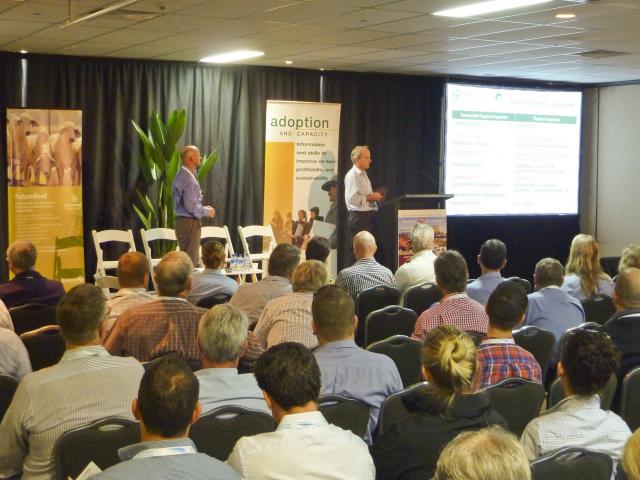
The Department of Agriculture and Food’s Northern Beef Futures (NBF) project contributed to the Northern Australia Beef Research Council meeting (NABRC) held in Rockhampton, Queensland in August.
The meeting of stakeholders included Producer Chairs from 11 Beef Research Committees together with representatives of MLA, state departments of agriculture, CSIRO and universities.
A workshop considered how a coalition of the stakeholders might progress collaborative beef research and development investment across northern Australia.
The meeting was followed by the Northern Beef Research Updates Conference (NBRUC) - the premier forum for promoting recent advances in beef industry research, development and adoption across northern Australia.
DAFWA’s NBF project was represented at the Conference with Dale Miles presenting a summary of the NBF project, highlighting its transformational nature and focus on connected supply chains and industry, and senior research officer Clinton Revell delivering presentations on mosaic agriculture development in the Pilbara and Kimberley regions.
Attendance and participation at the conference provided an opportunity to profile the NBF project to a broad spectrum of industry and producer groups, beyond Western Australia.
DAFWA's NBF project co-funded, in conjunction with Meat and Livestock Australia (MLA), assistance for producers and students in the State's Pilbara and Kimberley regions to attend NBRUC 2016.
This support covered the travel, accommodation and conference registration costs for four industry representatives from WA, enhancing opportunities for the local beef industry.
As a result, Murray Grey of Glenforrie Station, Maria Maughn an animal science student at Murdoch University, Jillian Fisher from Indigenous property Yandeyarra in the Pilbara, and Mike De Long from Dampier Downs Station were supported to attend the conference.
Key insights were that innovation and change are necessary for production and profitability improvements and that aggregation through integrated supply chains by producers is one of the key opportunities to remain competitive in our ever evolving beef industry.
It also helped build lines of communication with beef producers, service providers and other government and research organisations across northern Australia, particularly regarding improved beef industry practices and investment in research and development, adoption and extension, and how they create value.
Research presented at the conference included the areas of cattle nutrition and feed supplements, genetics, and animal health and welfare. The research papers are available at the NBRUC conference website
The NBF project’s main drivers, integrated supply chains and diversified markets, were the only market-pull approaches presented by the beef industry.
Mingenew Irwin Group (MIG) chairman Craig Forsyth further lifted the profile of the NBF project in his presentation about his beef production system and how it aligns with the MIG North-South Beef Alliance activity.
This alliance supports integrated supply chains by connecting pastoralists and farmers in the South West, particularly around backgrounding operations.
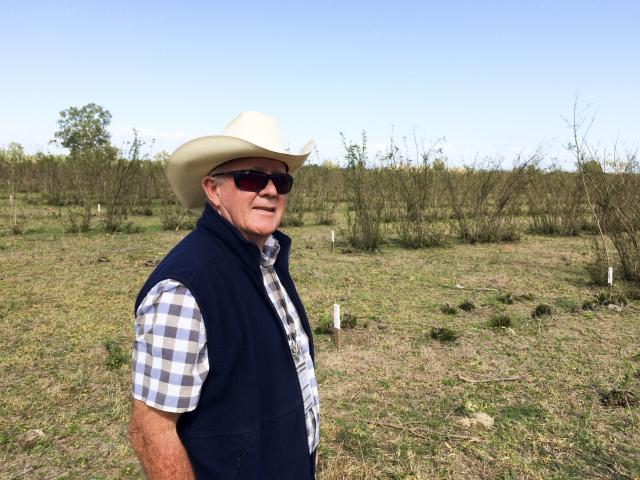
For more information contact Roger Verbrugge, DAFWA NBF Market Analyst on +61 (0)8 9780 6166 or nbf@agric.wa.gov.au
Resurgence in WA beef exports good news for industry
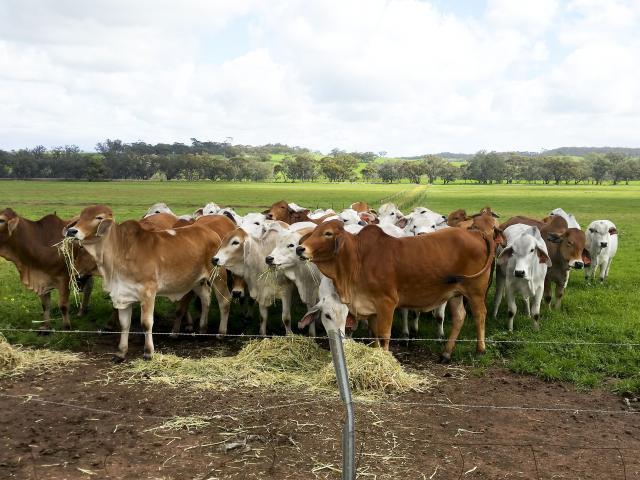
Western Australia’s beef exports have rebounded over the past three years to reach record levels, according to the Department of Agriculture and Food, Western Australia (DAFWA).
The WA Beef Commentary, published on 9 August, reports that between 2012 and 2015 the value of WA beef exports almost trebled, from AUD$68 million in 2012 to AUD$184 million in 2015.
DAFWA Northern Beef Futures project manager Manus Stockdale said the resurgence had been supported by strengthening demand from markets in Asia and the United States, and the easing of the Australian dollar.
The report highlighted that in 2015, the United States and Korea were the largest markets by value for WA beef, each accounting for 16 per cent of the value of WA beef exports, followed by Japan, Indonesia and China.
Live cattle exports from WA rose 64 per cent in value, from $154 million in 2012 to $253 million in 2015 - the highest value reached in the past decade.
Despite the strong export growth the domestic market remains significant for the WA beef industry, accounting for about 60 per cent of the State’s production.
The WA beef cattle herd stood at an estimated 2.24 million head in 2014-15.
So far this year, WA cattle market indicators have been very strong compared to previous years.
WA Beef Commentary is a biannual publication produced by the department, detailing market insights and the status of the beef industry, including production and export statistics.
Subscribe to ensure that you receive the latest Commentary.
The department’s $15 million Northern Beef Futures project, which is supporting the creation of new supply chains by broadening products, production systems and markets, is made possible by the State Government’s Royalties for Regions program.
For more information, contact Daniel Marshall, DAFWA NBF manager New Markets and New Supply Chains, on +61 (0)8 9780 6126 or nbf@agric.wa.gov.au
Rangelands grassfed beef assurance opportunities investigated
The potential for a grassfed beef assurance program in WA to take advantage of the clean and safe reputation of rangelands cattle has been assessed by the Department of Agriculture and Food (DAFWA).
DAFWA’s Northern Beef Futures (NBF) Market Analyst Dale Miles updated producers on the recently completed work examining prospects for a certified program at the DeGrey LCDC information day at Yarrie Station in the Pilbara on 29 July.
A prefeasibility analysis was carried out to determine whether margin gains could be achieved by developing a value-added grassfed product in an integrated supply chain.
Global demand for grassfed beef is on the rise and industry projections suggest demand will continue in key export markets, such as the United States.
Investments in irrigated precincts in the rangelands region present prospects to supply a more consistent product to markets and deliver a potential margin gain for producers under an auditable grassfed assurance program.
The Pilbara and parts of the Kimberley are in a position to produce beef that fits the requirements of a grassfed certification program, with some changes to current production practices.
In the past, inconsistent supply during dry periods limited the development of a program for the region.
Feedback sought from producers, processors and markets on the development of a quality assurance program in WA indicated that a number of pastoralists own or had access to farmland for backgrounding cattle in the agricultural region.
The transition of these farms, usually used for the live export market or prior to entry into southern processor markets, to certification under a grassfed program, could form part of a further integrated supply chain as a value driver and margin gain for industry and producers.
Further, the current investment in irrigated fodder systems and increased adoption rates of north-south integration through backgrounding could provide an alternative option for a grassfed solution.
DAFWA is collaborating with the MLA and the WA beef industry to prioritise next steps to consider the implementation of a pilot project through an expression of interest process.
The desktop study completed by Global Agri Solutions was jointly funded by DAFWA’s NBF project, made possible by the State Government's Royalties for Regions program, and the Meat and Livestock Australia Donor Company.
For more information contact Roger Verbrugge, DAFWA NBF Market Analyst on +61 (0)8 9780 6166 or nbf@agric.wa.gov.au

